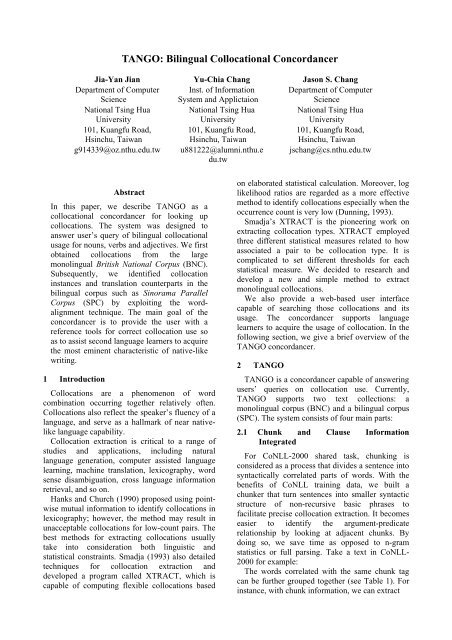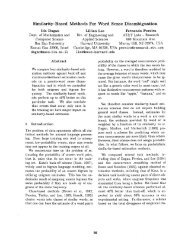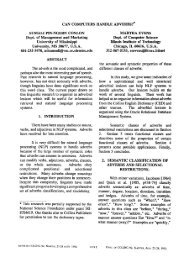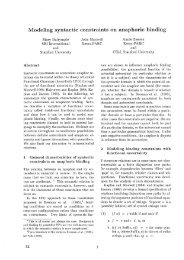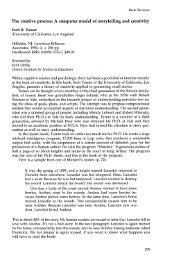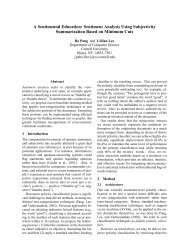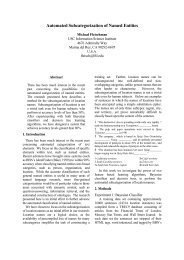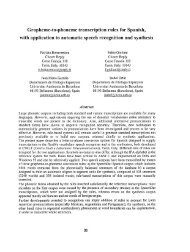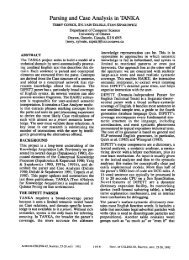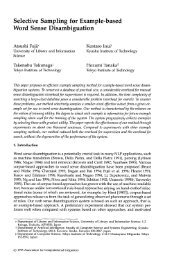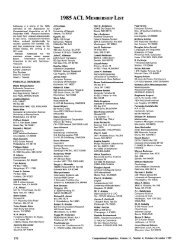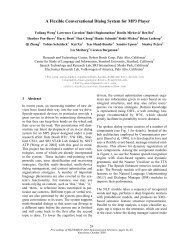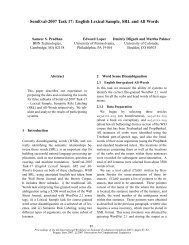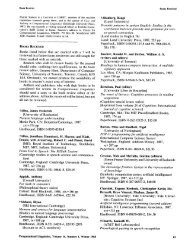TANGO: Bilingual Collocational Concordancer
TANGO: Bilingual Collocational Concordancer
TANGO: Bilingual Collocational Concordancer
You also want an ePaper? Increase the reach of your titles
YUMPU automatically turns print PDFs into web optimized ePapers that Google loves.
Jia-Yan Jian<br />
Department of Computer<br />
Science<br />
National Tsing Hua<br />
University<br />
101, Kuangfu Road,<br />
Hsinchu, Taiwan<br />
g914339@oz.nthu.edu.tw<br />
<strong>TANGO</strong>: <strong>Bilingual</strong> <strong>Collocational</strong> <strong>Concordancer</strong><br />
Abstract<br />
In this paper, we describe <strong>TANGO</strong> as a<br />
collocational concordancer for looking up<br />
collocations. The system was designed to<br />
answer user’s query of bilingual collocational<br />
usage for nouns, verbs and adjectives. We first<br />
obtained collocations from the large<br />
monolingual British National Corpus (BNC).<br />
Subsequently, we identified collocation<br />
instances and translation counterparts in the<br />
bilingual corpus such as Sinorama Parallel<br />
Corpus (SPC) by exploiting the wordalignment<br />
technique. The main goal of the<br />
concordancer is to provide the user with a<br />
reference tools for correct collocation use so<br />
as to assist second language learners to acquire<br />
the most eminent characteristic of native-like<br />
writing.<br />
1 Introduction<br />
Collocations are a phenomenon of word<br />
combination occurring together relatively often.<br />
Collocations also reflect the speaker’s fluency of a<br />
language, and serve as a hallmark of near nativelike<br />
language capability.<br />
Collocation extraction is critical to a range of<br />
studies and applications, including natural<br />
language generation, computer assisted language<br />
learning, machine translation, lexicography, word<br />
sense disambiguation, cross language information<br />
retrieval, and so on.<br />
Hanks and Church (1990) proposed using pointwise<br />
mutual information to identify collocations in<br />
lexicography; however, the method may result in<br />
unacceptable collocations for low-count pairs. The<br />
best methods for extracting collocations usually<br />
take into consideration both linguistic and<br />
statistical constraints. Smadja (1993) also detailed<br />
techniques for collocation extraction and<br />
developed a program called XTRACT, which is<br />
capable of computing flexible collocations based<br />
Yu-Chia Chang<br />
Inst. of Information<br />
System and Applictaion<br />
National Tsing Hua<br />
University<br />
101, Kuangfu Road,<br />
Hsinchu, Taiwan<br />
u881222@alumni.nthu.e<br />
du.tw<br />
Jason S. Chang<br />
Department of Computer<br />
Science<br />
National Tsing Hua<br />
University<br />
101, Kuangfu Road,<br />
Hsinchu, Taiwan<br />
jschang@cs.nthu.edu.tw<br />
on elaborated statistical calculation. Moreover, log<br />
likelihood ratios are regarded as a more effective<br />
method to identify collocations especially when the<br />
occurrence count is very low (Dunning, 1993).<br />
Smadja’s XTRACT is the pioneering work on<br />
extracting collocation types. XTRACT employed<br />
three different statistical measures related to how<br />
associated a pair to be collocation type. It is<br />
complicated to set different thresholds for each<br />
statistical measure. We decided to research and<br />
develop a new and simple method to extract<br />
monolingual collocations.<br />
We also provide a web-based user interface<br />
capable of searching those collocations and its<br />
usage. The concordancer supports language<br />
learners to acquire the usage of collocation. In the<br />
following section, we give a brief overview of the<br />
<strong>TANGO</strong> concordancer.<br />
2 <strong>TANGO</strong><br />
<strong>TANGO</strong> is a concordancer capable of answering<br />
users’ queries on collocation use. Currently,<br />
<strong>TANGO</strong> supports two text collections: a<br />
monolingual corpus (BNC) and a bilingual corpus<br />
(SPC). The system consists of four main parts:<br />
2.1 Chunk and Clause Information<br />
Integrated<br />
For CoNLL-2000 shared task, chunking is<br />
considered as a process that divides a sentence into<br />
syntactically correlated parts of words. With the<br />
benefits of CoNLL training data, we built a<br />
chunker that turn sentences into smaller syntactic<br />
structure of non-recursive basic phrases to<br />
facilitate precise collocation extraction. It becomes<br />
easier to identify the argument-predicate<br />
relationship by looking at adjacent chunks. By<br />
doing so, we save time as opposed to n-gram<br />
statistics or full parsing. Take a text in CoNLL-<br />
2000 for example:<br />
The words correlated with the same chunk tag<br />
can be further grouped together (see Table 1). For<br />
instance, with chunk information, we can extract
Type Collocation types in BNC<br />
VN 631,638<br />
VPN 15,394<br />
VNP 14,008<br />
Table 3: The result of collocation types extracted<br />
from BNC and collocation instances identified in<br />
SPC<br />
2.4 Extracting <strong>Collocational</strong> Translation<br />
Equivalents in <strong>Bilingual</strong> Corpus<br />
When accurate instances are obtained from<br />
bilingual corpus, we continue to integrate the<br />
statistical word-alignment techniques (Melamed,<br />
1997) and dictionaries to find the translation<br />
candidates for each of the two collocates. We first<br />
locate the translation of the noun. Subsequently,<br />
we locate the verb nearest to the noun translation<br />
to find the translation for the verb. We can think of<br />
collocation with corresponding translations as a<br />
kind of translation memory (shows in Table 2).The<br />
implementation result of BNC and SPC shows in<br />
the Table 3, 4, and 5.<br />
3 Collocation Concordance<br />
With the collocation types and instances<br />
extracted from the corpus, we built an online<br />
collocational concordancer called <strong>TANGO</strong> for<br />
looking up translation memory. A user can type in<br />
any English query and select the intended part of<br />
speech of query and collocate. For example in<br />
Figure 1, after query for the verb collocates of the<br />
noun “influence” is submitted, the results are<br />
displayed on the return page. The user can then<br />
browse through different collocates types and also<br />
click to get to see all the instances of a certain<br />
collocation type.<br />
Noun VN types<br />
Language 320<br />
Influence 319<br />
Threat 222<br />
Doubt 199<br />
Crime 183<br />
Phone 137<br />
Cigarette 121<br />
Throat 86<br />
Living 79<br />
Suicide 47<br />
Table 4: Examples of collocation types including<br />
a given noun in BNC<br />
VN type Example<br />
Exert<br />
influence<br />
Exercise<br />
influence<br />
Wield<br />
influence<br />
That means they would<br />
already be exerting their<br />
influence by the time the<br />
microwave background was<br />
born.<br />
The Davies brothers, Adrian<br />
(who scored 14 points) and<br />
Graham (four), exercised an<br />
important creative influence<br />
on Cambridge fortunes while<br />
their flankers Holmes and<br />
Pool-Jones were full of fire<br />
and tenacity in the loose.<br />
Fortunately, George V had<br />
worked well with his father<br />
and knew the nature of the<br />
current political trends, but he<br />
did not wield the same<br />
influence internationally as his<br />
esteemed father.<br />
Table 5: Examples of collocation instances<br />
extracted from SPC<br />
Moreover, using the technique of bilingual<br />
collocation alignment and sentence alignment, the<br />
system will display the target collocation with<br />
highlight to show translation equivalents in context.<br />
Translators or learners, through this webbased<br />
interface, can easily acquire the usage of<br />
each collocation with relevant instances. This<br />
collocational concordancer is a very useful tool for<br />
self-inductive learning tailored to intermedi-ate or<br />
advanced English learners.<br />
Users can obtain the result of the VN or AN<br />
collocations related to their query. <strong>TANGO</strong> shows<br />
the collocation types and instances with<br />
collocations and translation counterparts highlighted.<br />
The evaluation (shows in Table 6) indicates an<br />
average precision of 89.3 % with regard to<br />
satisfactory.<br />
4 Conclusion and Future Work<br />
In this paper, we describe an algorithm that<br />
employs linguistic and statistical analyses to<br />
extract instance of VN collocations from a very<br />
large corpus; we also identify the corresponding<br />
translations in a parallel corpus. The algorithm is<br />
applicable to other types of collocations without<br />
being limited by collocation’s span. The main<br />
difference between our algorithm and previous<br />
work lies in that we extract valid instances instead<br />
of types, based on linguistic information of chunks<br />
and clauses. Moreover, in our research we observe
Type The number of<br />
selected<br />
sentences<br />
Translation<br />
Memory<br />
Translation<br />
Memory (*)<br />
Precision of<br />
Translation<br />
Memory<br />
VN 100 73 90 73 90<br />
VPN 100 66 89 66 89<br />
VNP 100 78 89 78 89<br />
Precision of<br />
Translation<br />
Memory (*)<br />
Table 6: Experiment result of collocational translation memory from Sinorama parallel Corpus<br />
other types related to VN such as VPN (ie. verb +<br />
preposition + noun) and VNP (ie. verb + noun +<br />
preposition), which will also be crucial for<br />
machine translation and computer assisted<br />
language learning. In the future, we will apply our<br />
method to more types of collocations, to pave the<br />
way for more comprehensive applications.<br />
Acknowledgements<br />
This work is carried out under the project<br />
“CANDLE” funded by National Science Council<br />
in Taiwan (NSC92-2524-S007-002). Further<br />
information about CANDLE is available at<br />
http://candle.cs.nthu.edu.tw/.<br />
References<br />
Dunning, T (1993) Accurate methods for the statistics<br />
of surprise and coincidence, Computational<br />
Linguistics 19:1, 61-75.<br />
Hanks, P. and Church, K. W. Word association norms,<br />
mutual information, and lexicography.<br />
Computational Linguistics, 1990, 16(1), pp. 22-29.<br />
Melamed, I. Dan. "A Word-to-Word Model of<br />
Translational Equivalence". In Procs. of the ACL97.<br />
pp 490-497. Madrid Spain, 1997.<br />
Smadja, F. 1993. Retrieving collocations from text:<br />
Xtract. Computational Linguistics, 19(1):143-177.<br />
Figure 1: The caption of the table


